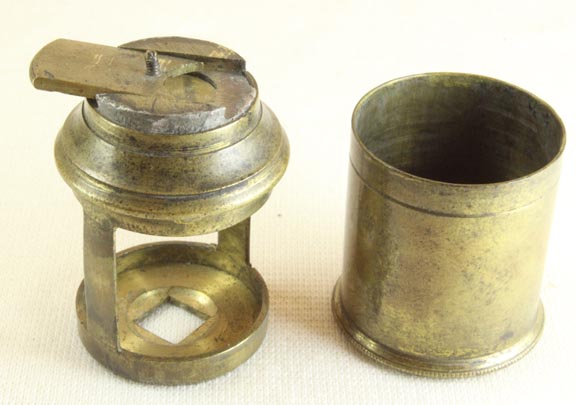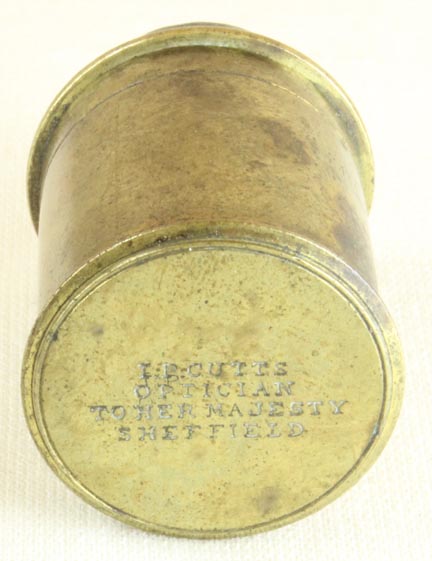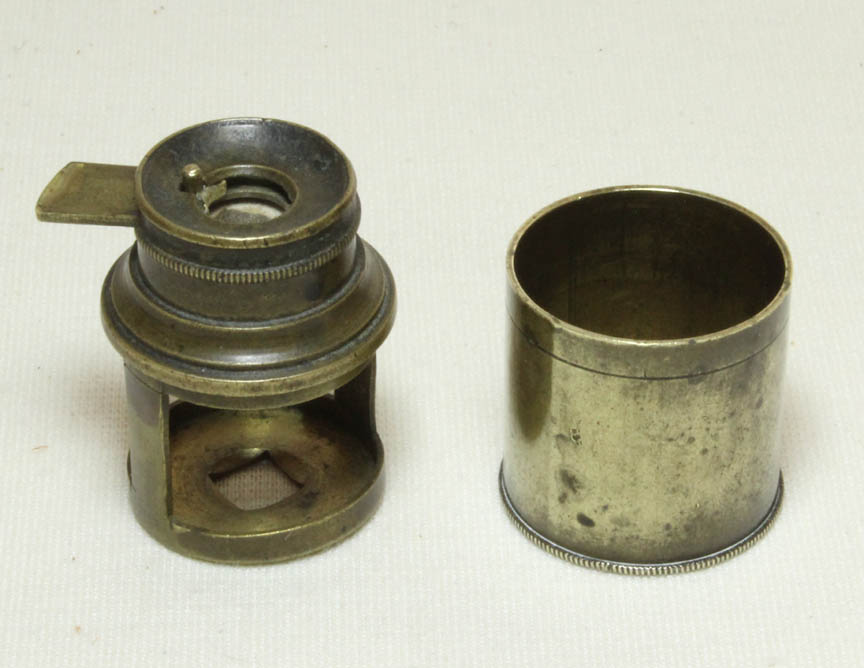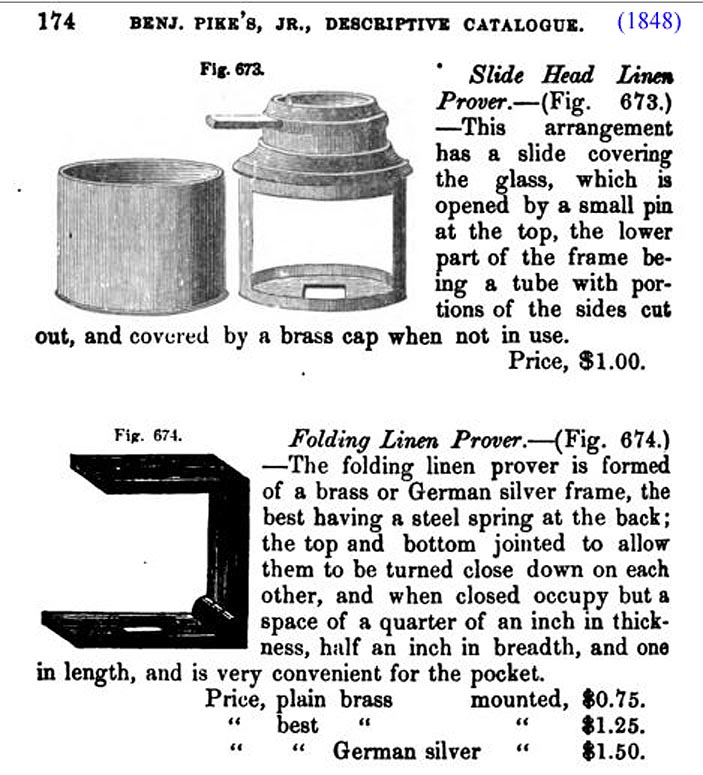SLIDE-HEAD TYPE LINEN PROVER MICROSCOPES:
2ND QUARTER, 19TH CENTURY
The 'slide-head' type of linen prover, is illustrated on this page. These two examples are likely the earliest linen provers in this collection, and the signed one likely has the earliest signature of any linen prover known. Unfortunately, the signed example has lost its top cap. Fortunately, the other example illustrates it quite well.
DESCRIPTIONS

 From the second quarter of the 19th century, this slide-head prover is signed: 'I. P. Cutts, Optician, to Her Majesty, Sheffield.' The initials 'I.P. are actually those of John Priston Cutts, who, according to City records, was working under his name only from 1822 to 1841, although his advertisments state the firm was founded in 1804.
We can date his instrument to before 1840 when his sons joined the firm and after 1837 when Queen when Victoria came to the throne (thanks to Brian Stevenson for this additional dating information). Cutts sometimes used the old fashioned 'I' for the 'J' These two initials are actually imprinted on this case twice, one slightly above the other; this is best appreciated in an enlarged view. Cutts also sold an example of the Cary-Gould type microscope and many other types of instruments.
From the second quarter of the 19th century, this slide-head prover is signed: 'I. P. Cutts, Optician, to Her Majesty, Sheffield.' The initials 'I.P. are actually those of John Priston Cutts, who, according to City records, was working under his name only from 1822 to 1841, although his advertisments state the firm was founded in 1804.
We can date his instrument to before 1840 when his sons joined the firm and after 1837 when Queen when Victoria came to the throne (thanks to Brian Stevenson for this additional dating information). Cutts sometimes used the old fashioned 'I' for the 'J' These two initials are actually imprinted on this case twice, one slightly above the other; this is best appreciated in an enlarged view. Cutts also sold an example of the Cary-Gould type microscope and many other types of instruments.
 This second example is identical to the first, including the case, except that the diameter of the lens is 2 mm larger and the slide therefore proportionately wider. Unlike the first example, this one is complete with its cap. Other than the diameter of the lens, slider width, and cap size, this example has identical features as the signed one above. The outer diameter and heights are exactly the same.
This second example is identical to the first, including the case, except that the diameter of the lens is 2 mm larger and the slide therefore proportionately wider. Unlike the first example, this one is complete with its cap. Other than the diameter of the lens, slider width, and cap size, this example has identical features as the signed one above. The outer diameter and heights are exactly the same.

 From the second quarter of the 19th century, this slide-head prover is signed: 'I. P. Cutts, Optician, to Her Majesty, Sheffield.' The initials 'I.P. are actually those of John Priston Cutts, who, according to City records, was working under his name only from 1822 to 1841, although his advertisments state the firm was founded in 1804.
We can date his instrument to before 1840 when his sons joined the firm and after 1837 when Queen when Victoria came to the throne (thanks to Brian Stevenson for this additional dating information). Cutts sometimes used the old fashioned 'I' for the 'J' These two initials are actually imprinted on this case twice, one slightly above the other; this is best appreciated in an enlarged view. Cutts also sold an example of the Cary-Gould type microscope and many other types of instruments.
From the second quarter of the 19th century, this slide-head prover is signed: 'I. P. Cutts, Optician, to Her Majesty, Sheffield.' The initials 'I.P. are actually those of John Priston Cutts, who, according to City records, was working under his name only from 1822 to 1841, although his advertisments state the firm was founded in 1804.
We can date his instrument to before 1840 when his sons joined the firm and after 1837 when Queen when Victoria came to the throne (thanks to Brian Stevenson for this additional dating information). Cutts sometimes used the old fashioned 'I' for the 'J' These two initials are actually imprinted on this case twice, one slightly above the other; this is best appreciated in an enlarged view. Cutts also sold an example of the Cary-Gould type microscope and many other types of instruments.
 This second example is identical to the first, including the case, except that the diameter of the lens is 2 mm larger and the slide therefore proportionately wider. Unlike the first example, this one is complete with its cap. Other than the diameter of the lens, slider width, and cap size, this example has identical features as the signed one above. The outer diameter and heights are exactly the same.
This second example is identical to the first, including the case, except that the diameter of the lens is 2 mm larger and the slide therefore proportionately wider. Unlike the first example, this one is complete with its cap. Other than the diameter of the lens, slider width, and cap size, this example has identical features as the signed one above. The outer diameter and heights are exactly the same.  This type of linen prover was commonly offered for sale in the nineteenth century, but supplanted by the Folding 'C' form and the 'Thread Counter' in the early twentieth century. For more about the history of linen provers, see the history section of the article about linen provers. For more about Cutts, see Brian Davidson's article.
This type of linen prover was commonly offered for sale in the nineteenth century, but supplanted by the Folding 'C' form and the 'Thread Counter' in the early twentieth century. For more about the history of linen provers, see the history section of the article about linen provers. For more about Cutts, see Brian Davidson's article.